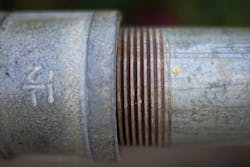Testing: Assessing Lead Risks
With all of the media attention currently surrounding lead in water, people should consider whether their water is safe to drink. In the wake of the Flint, Mich., water contamination crisis, hundreds of news stories about lead have been published, including reports on test results from schools that are being proactive and testing their water, water supplies that have exceeded the action levels and water authorities trying to reassure customers the water they provide is safe.
There is a significant amount of controversy surrounding the topic of lead in drinking water, including accusations by the media that some cities are “gaming the system” when it comes to performing the lead and copper testing required by the Safe Drinking Water Act. There are many sides to this complicated issue, and this article will explore the regulations and the risks.
Lead Laws Through the Years
The rules for lead and copper in water have changed over the years. Lead originally was regulated under the Public Health Service Act of 1962, which established a guideline of 0.050 mg/L for lead in drinking water. This was carried over into the Safe Drinking Water Act of 1974.
It was not until 1991 that regulations changed significantly under the Lead and Copper Rule, which regulates how public water supplies should handle potential lead and copper in drinking water. This rule is extremely complicated, so it is likely systems—let alone consumers—may not know all the intricacies. There is also the Reduction of Lead in Drinking Water Act, which regulates the amount of lead allowed in products that could come in contact with drinking water, such as pipe, plumbing fittings, fixtures, solder and flux.
Following is a basic overview of the Lead and Copper Rule that does not address all of the requirements. This rule requires public water systems take a certain number of samples based on the population they serve. Smaller systems take fewer samples, while larger systems take more samples, with a cap of 100 samples. The samples must be taken within the distribution systems at homes with higher risk for lead contamination.
If fewer than 10% of samples exceed the action levels, then the system meets the requirements of the rule. Systems may be eligible for reduced monitoring if they meet those requirements for two consecutive monitoring periods. Reduced monitoring cuts the number of required samples in half, so the largest systems would only look at 50 samples.
If 10% of the samples exceed the action levels for lead and copper, a system must take action. It must perform a corrosion control study, which entails more monitoring for factors that may affect corrosion, like alkalinity and pH. Typically, systems utilize a corrosion inhibitor, which coats the inside of pipe. Corrosion inhibitors usually have a phosphate or silica base, so they also potentially would need to be monitored.
The states, which have primacy to implement the Safe Drinking Water Act, may have slightly different requirements for monitoring when it comes to corrosion control studies. When systems implement treatment with a corrosion inhibitor, the state should assist them in getting results that meet the requirements.
Testing Best Practices
There are a variety of ways a water supply could get inaccurate or misleading testing results. The first possibility is the sample site. Water systems are supposed to choose high-risk buildings, like those built prior to 1986, when lead was widely used in solder, flux and some plumbing fixtures and pipe materials. The systems also are expected to collect samples from areas that may be served by a lead main. While locating high-risk buildings served by lead mains may prove difficult due to old or incomplete records, collecting samples from the same locations every monitoring period can help ensure the results consistently are below the action levels. Collecting samples only from low-risk buildings would significantly skew lead testing results.
Another factor in testing accuracy is how samples are collected. Some systems have recommended running the water for several minutes, thus flushing the system, the night before the sample is collected. This can reduce the amount of lead in that sample. Other questionable practices include removing the aerator when collecting a sample, which can wash away any lead particles that may be present, resulting in lower levels being detected.
Assessing Risk
Everyone is at risk for lead contamination—lead has been prevalent in many products that come into contact with drinking water over the years. In June 1986, a ban was enacted on the use of lead-containing materials in anything that would come in contact with drinking water. Homes built prior to 1986 are at higher risk for lead contamination, because there is a good chance that some of the plumbing materials contained lead. Newer homes are also at risk, however, because “lead-free” materials still could legally contain up to 8% lead.
New homeowners are presented with a brochure about the dangers of lead and the opportunity to do a lead risk assessment, which is mainly geared toward lead paint. They have to sign a waiver if they do not do a lead assessment. This is the ideal time to get a lead test done.
When I purchased my first home, I immediately had the water tested—even though it was city water, I wanted to know whether I should treat it further. I found I had lead in my water at 0.009 mg/L. While public water supplies will tell you this is a safe level, I know that lead at any level is unsafe to consume. I immediately took steps to purchase a system that reduced the lead level.
Download: Here
